Report: Key Parameters Determining Water Health in Aquatic Systems
VerifiedAdded on 2023/06/11
|7
|1909
|311
Report
AI Summary
This report comprehensively examines the critical parameters that determine water health in aquatic ecosystems, emphasizing the significance of factors like dissolved oxygen, temperature, pH, electrical conductivity, turbidity, nitrogen and phosphate levels, and the presence of coliform bacteria. It highlights how these parameters affect aquatic life, detailing the impact of human actions such as deforestation, pollution, and ozone depletion on water quality. The report further suggests recommendations for maintaining good water health, including reducing deforestation, promoting reforestation, using mild agricultural chemicals, and properly disposing of industrial waste to mitigate adverse effects on water bodies and ensure the well-being of both aquatic organisms and human populations.
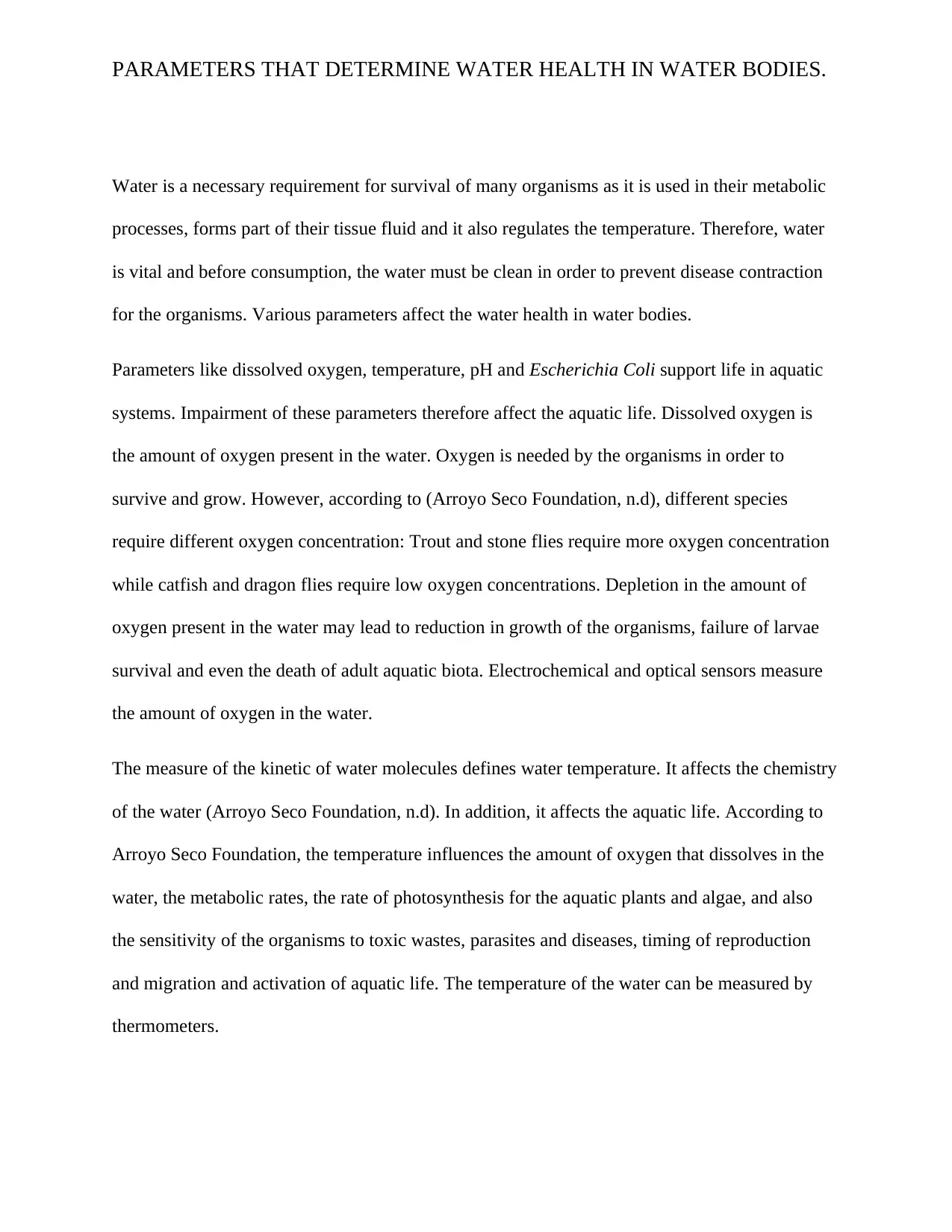
PARAMETERS THAT DETERMINE WATER HEALTH IN WATER BODIES.
Water is a necessary requirement for survival of many organisms as it is used in their metabolic
processes, forms part of their tissue fluid and it also regulates the temperature. Therefore, water
is vital and before consumption, the water must be clean in order to prevent disease contraction
for the organisms. Various parameters affect the water health in water bodies.
Parameters like dissolved oxygen, temperature, pH and Escherichia Coli support life in aquatic
systems. Impairment of these parameters therefore affect the aquatic life. Dissolved oxygen is
the amount of oxygen present in the water. Oxygen is needed by the organisms in order to
survive and grow. However, according to (Arroyo Seco Foundation, n.d), different species
require different oxygen concentration: Trout and stone flies require more oxygen concentration
while catfish and dragon flies require low oxygen concentrations. Depletion in the amount of
oxygen present in the water may lead to reduction in growth of the organisms, failure of larvae
survival and even the death of adult aquatic biota. Electrochemical and optical sensors measure
the amount of oxygen in the water.
The measure of the kinetic of water molecules defines water temperature. It affects the chemistry
of the water (Arroyo Seco Foundation, n.d). In addition, it affects the aquatic life. According to
Arroyo Seco Foundation, the temperature influences the amount of oxygen that dissolves in the
water, the metabolic rates, the rate of photosynthesis for the aquatic plants and algae, and also
the sensitivity of the organisms to toxic wastes, parasites and diseases, timing of reproduction
and migration and activation of aquatic life. The temperature of the water can be measured by
thermometers.
Water is a necessary requirement for survival of many organisms as it is used in their metabolic
processes, forms part of their tissue fluid and it also regulates the temperature. Therefore, water
is vital and before consumption, the water must be clean in order to prevent disease contraction
for the organisms. Various parameters affect the water health in water bodies.
Parameters like dissolved oxygen, temperature, pH and Escherichia Coli support life in aquatic
systems. Impairment of these parameters therefore affect the aquatic life. Dissolved oxygen is
the amount of oxygen present in the water. Oxygen is needed by the organisms in order to
survive and grow. However, according to (Arroyo Seco Foundation, n.d), different species
require different oxygen concentration: Trout and stone flies require more oxygen concentration
while catfish and dragon flies require low oxygen concentrations. Depletion in the amount of
oxygen present in the water may lead to reduction in growth of the organisms, failure of larvae
survival and even the death of adult aquatic biota. Electrochemical and optical sensors measure
the amount of oxygen in the water.
The measure of the kinetic of water molecules defines water temperature. It affects the chemistry
of the water (Arroyo Seco Foundation, n.d). In addition, it affects the aquatic life. According to
Arroyo Seco Foundation, the temperature influences the amount of oxygen that dissolves in the
water, the metabolic rates, the rate of photosynthesis for the aquatic plants and algae, and also
the sensitivity of the organisms to toxic wastes, parasites and diseases, timing of reproduction
and migration and activation of aquatic life. The temperature of the water can be measured by
thermometers.
Paraphrase This Document
Need a fresh take? Get an instant paraphrase of this document with our AI Paraphraser
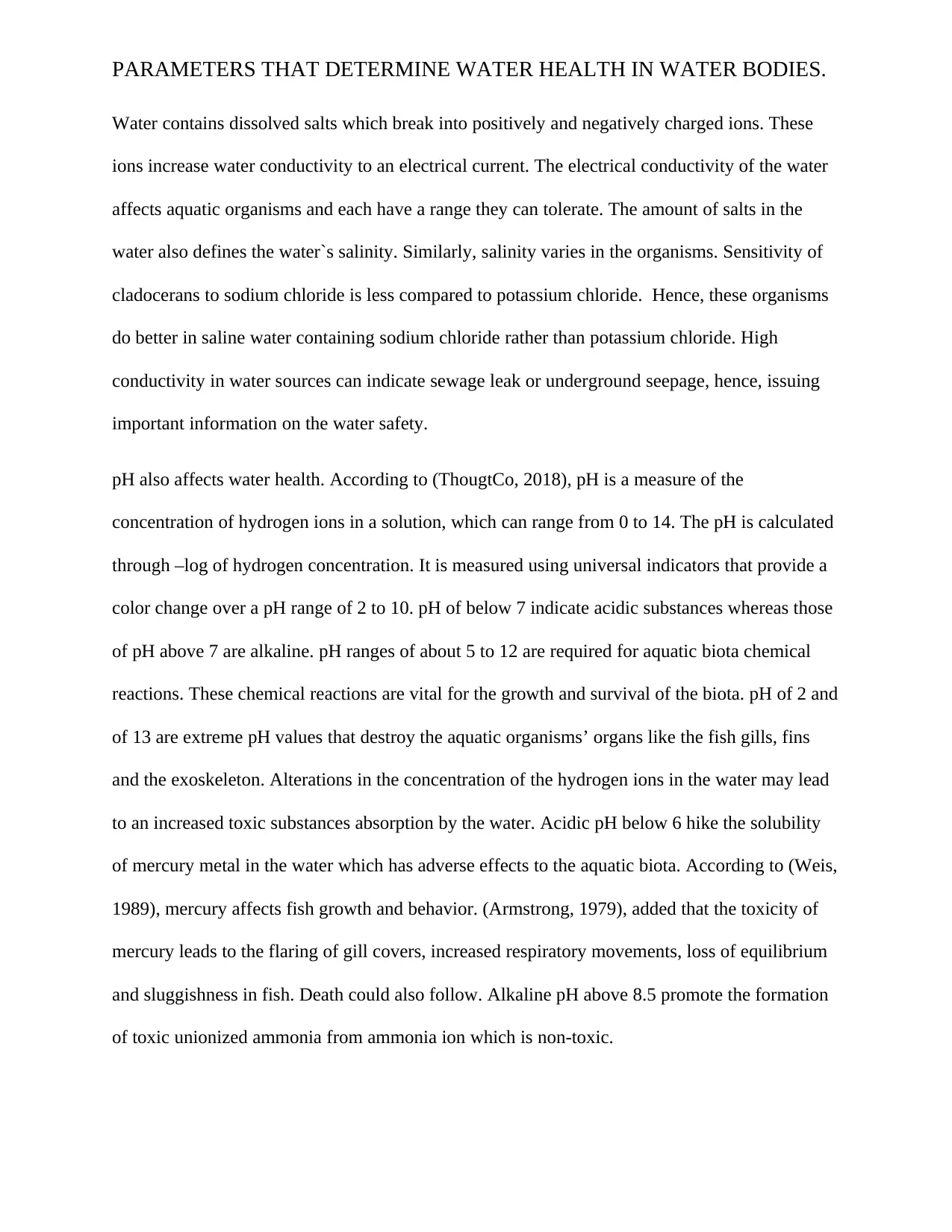
PARAMETERS THAT DETERMINE WATER HEALTH IN WATER BODIES.
Water contains dissolved salts which break into positively and negatively charged ions. These
ions increase water conductivity to an electrical current. The electrical conductivity of the water
affects aquatic organisms and each have a range they can tolerate. The amount of salts in the
water also defines the water`s salinity. Similarly, salinity varies in the organisms. Sensitivity of
cladocerans to sodium chloride is less compared to potassium chloride. Hence, these organisms
do better in saline water containing sodium chloride rather than potassium chloride. High
conductivity in water sources can indicate sewage leak or underground seepage, hence, issuing
important information on the water safety.
pH also affects water health. According to (ThougtCo, 2018), pH is a measure of the
concentration of hydrogen ions in a solution, which can range from 0 to 14. The pH is calculated
through –log of hydrogen concentration. It is measured using universal indicators that provide a
color change over a pH range of 2 to 10. pH of below 7 indicate acidic substances whereas those
of pH above 7 are alkaline. pH ranges of about 5 to 12 are required for aquatic biota chemical
reactions. These chemical reactions are vital for the growth and survival of the biota. pH of 2 and
of 13 are extreme pH values that destroy the aquatic organisms’ organs like the fish gills, fins
and the exoskeleton. Alterations in the concentration of the hydrogen ions in the water may lead
to an increased toxic substances absorption by the water. Acidic pH below 6 hike the solubility
of mercury metal in the water which has adverse effects to the aquatic biota. According to (Weis,
1989), mercury affects fish growth and behavior. (Armstrong, 1979), added that the toxicity of
mercury leads to the flaring of gill covers, increased respiratory movements, loss of equilibrium
and sluggishness in fish. Death could also follow. Alkaline pH above 8.5 promote the formation
of toxic unionized ammonia from ammonia ion which is non-toxic.
Water contains dissolved salts which break into positively and negatively charged ions. These
ions increase water conductivity to an electrical current. The electrical conductivity of the water
affects aquatic organisms and each have a range they can tolerate. The amount of salts in the
water also defines the water`s salinity. Similarly, salinity varies in the organisms. Sensitivity of
cladocerans to sodium chloride is less compared to potassium chloride. Hence, these organisms
do better in saline water containing sodium chloride rather than potassium chloride. High
conductivity in water sources can indicate sewage leak or underground seepage, hence, issuing
important information on the water safety.
pH also affects water health. According to (ThougtCo, 2018), pH is a measure of the
concentration of hydrogen ions in a solution, which can range from 0 to 14. The pH is calculated
through –log of hydrogen concentration. It is measured using universal indicators that provide a
color change over a pH range of 2 to 10. pH of below 7 indicate acidic substances whereas those
of pH above 7 are alkaline. pH ranges of about 5 to 12 are required for aquatic biota chemical
reactions. These chemical reactions are vital for the growth and survival of the biota. pH of 2 and
of 13 are extreme pH values that destroy the aquatic organisms’ organs like the fish gills, fins
and the exoskeleton. Alterations in the concentration of the hydrogen ions in the water may lead
to an increased toxic substances absorption by the water. Acidic pH below 6 hike the solubility
of mercury metal in the water which has adverse effects to the aquatic biota. According to (Weis,
1989), mercury affects fish growth and behavior. (Armstrong, 1979), added that the toxicity of
mercury leads to the flaring of gill covers, increased respiratory movements, loss of equilibrium
and sluggishness in fish. Death could also follow. Alkaline pH above 8.5 promote the formation
of toxic unionized ammonia from ammonia ion which is non-toxic.
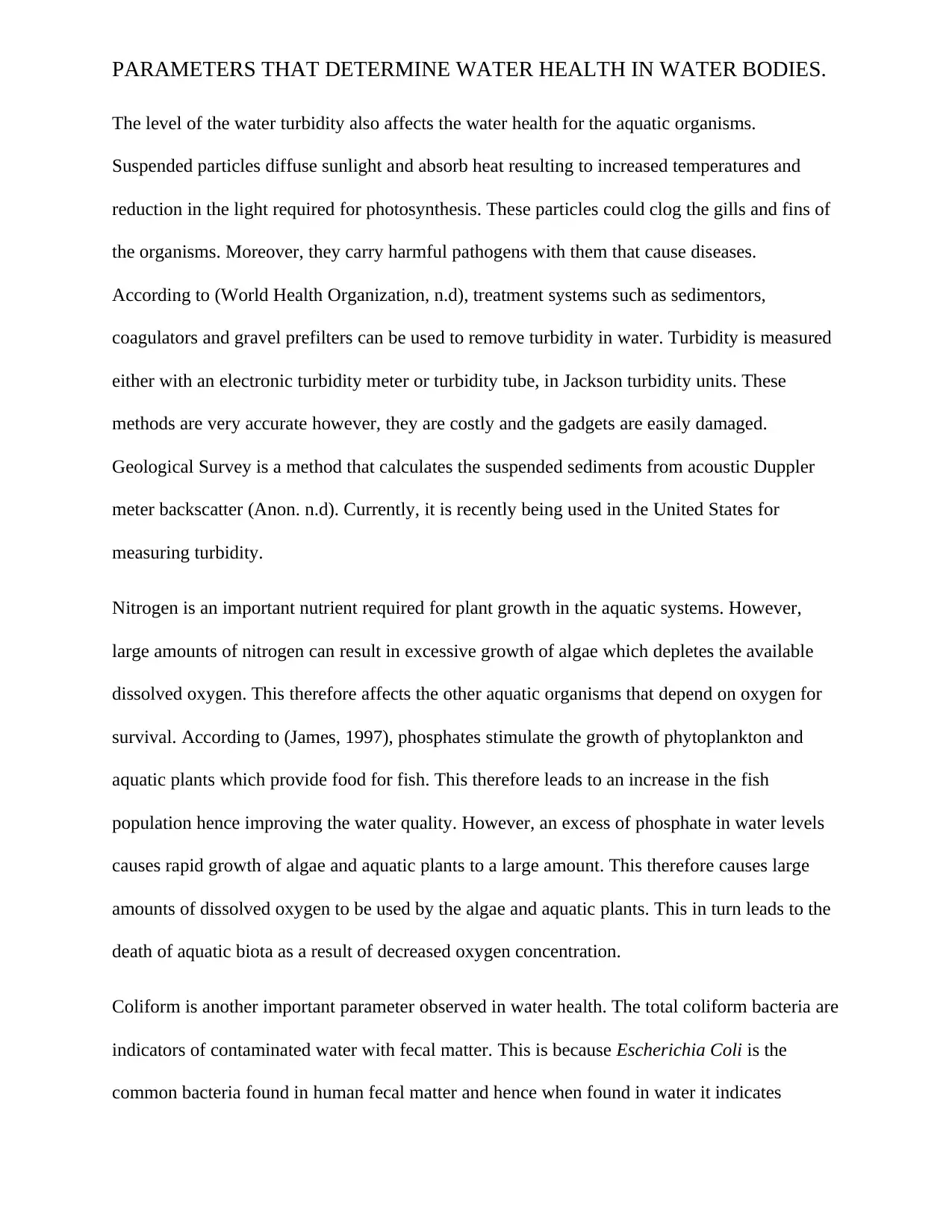
PARAMETERS THAT DETERMINE WATER HEALTH IN WATER BODIES.
The level of the water turbidity also affects the water health for the aquatic organisms.
Suspended particles diffuse sunlight and absorb heat resulting to increased temperatures and
reduction in the light required for photosynthesis. These particles could clog the gills and fins of
the organisms. Moreover, they carry harmful pathogens with them that cause diseases.
According to (World Health Organization, n.d), treatment systems such as sedimentors,
coagulators and gravel prefilters can be used to remove turbidity in water. Turbidity is measured
either with an electronic turbidity meter or turbidity tube, in Jackson turbidity units. These
methods are very accurate however, they are costly and the gadgets are easily damaged.
Geological Survey is a method that calculates the suspended sediments from acoustic Duppler
meter backscatter (Anon. n.d). Currently, it is recently being used in the United States for
measuring turbidity.
Nitrogen is an important nutrient required for plant growth in the aquatic systems. However,
large amounts of nitrogen can result in excessive growth of algae which depletes the available
dissolved oxygen. This therefore affects the other aquatic organisms that depend on oxygen for
survival. According to (James, 1997), phosphates stimulate the growth of phytoplankton and
aquatic plants which provide food for fish. This therefore leads to an increase in the fish
population hence improving the water quality. However, an excess of phosphate in water levels
causes rapid growth of algae and aquatic plants to a large amount. This therefore causes large
amounts of dissolved oxygen to be used by the algae and aquatic plants. This in turn leads to the
death of aquatic biota as a result of decreased oxygen concentration.
Coliform is another important parameter observed in water health. The total coliform bacteria are
indicators of contaminated water with fecal matter. This is because Escherichia Coli is the
common bacteria found in human fecal matter and hence when found in water it indicates
The level of the water turbidity also affects the water health for the aquatic organisms.
Suspended particles diffuse sunlight and absorb heat resulting to increased temperatures and
reduction in the light required for photosynthesis. These particles could clog the gills and fins of
the organisms. Moreover, they carry harmful pathogens with them that cause diseases.
According to (World Health Organization, n.d), treatment systems such as sedimentors,
coagulators and gravel prefilters can be used to remove turbidity in water. Turbidity is measured
either with an electronic turbidity meter or turbidity tube, in Jackson turbidity units. These
methods are very accurate however, they are costly and the gadgets are easily damaged.
Geological Survey is a method that calculates the suspended sediments from acoustic Duppler
meter backscatter (Anon. n.d). Currently, it is recently being used in the United States for
measuring turbidity.
Nitrogen is an important nutrient required for plant growth in the aquatic systems. However,
large amounts of nitrogen can result in excessive growth of algae which depletes the available
dissolved oxygen. This therefore affects the other aquatic organisms that depend on oxygen for
survival. According to (James, 1997), phosphates stimulate the growth of phytoplankton and
aquatic plants which provide food for fish. This therefore leads to an increase in the fish
population hence improving the water quality. However, an excess of phosphate in water levels
causes rapid growth of algae and aquatic plants to a large amount. This therefore causes large
amounts of dissolved oxygen to be used by the algae and aquatic plants. This in turn leads to the
death of aquatic biota as a result of decreased oxygen concentration.
Coliform is another important parameter observed in water health. The total coliform bacteria are
indicators of contaminated water with fecal matter. This is because Escherichia Coli is the
common bacteria found in human fecal matter and hence when found in water it indicates
⊘ This is a preview!⊘
Do you want full access?
Subscribe today to unlock all pages.

Trusted by 1+ million students worldwide
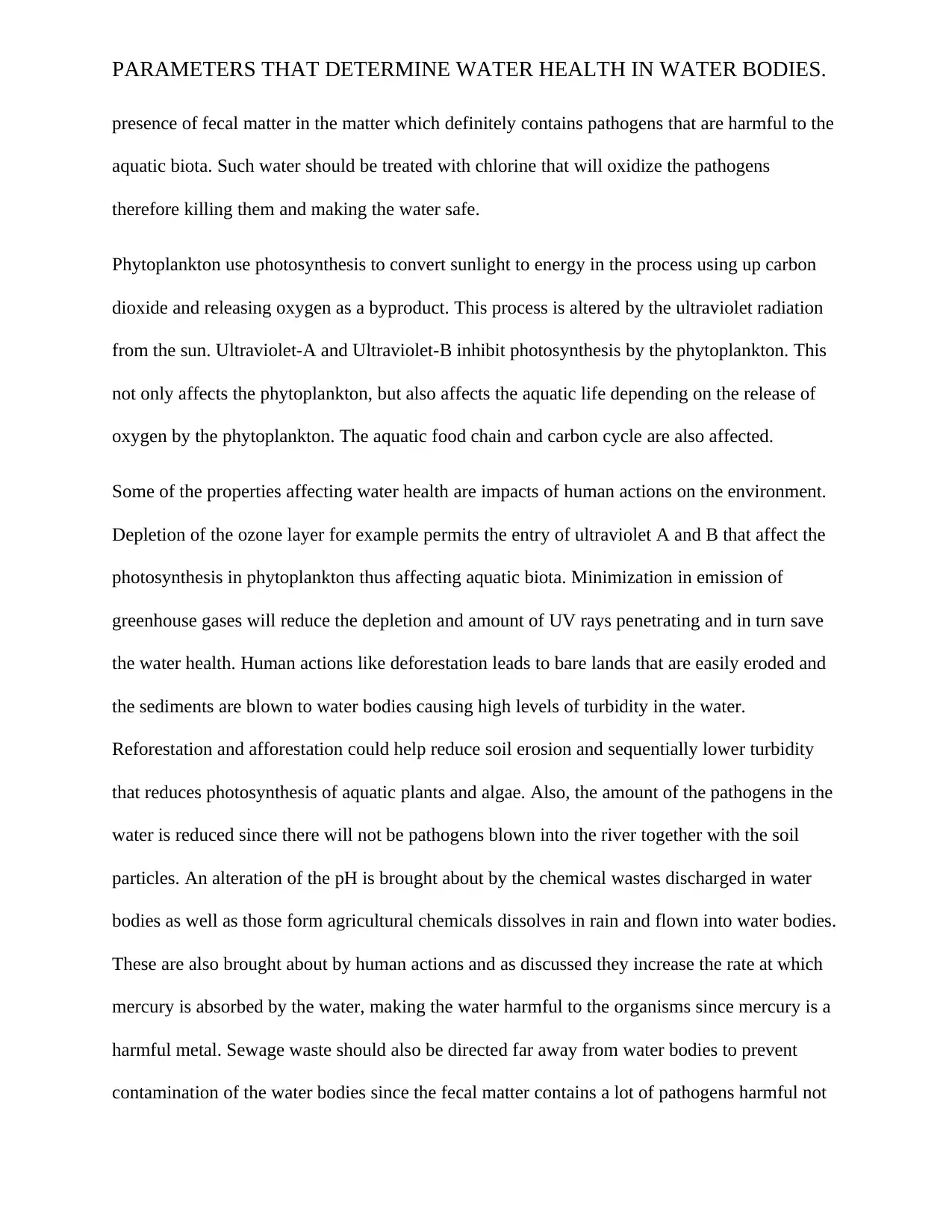
PARAMETERS THAT DETERMINE WATER HEALTH IN WATER BODIES.
presence of fecal matter in the matter which definitely contains pathogens that are harmful to the
aquatic biota. Such water should be treated with chlorine that will oxidize the pathogens
therefore killing them and making the water safe.
Phytoplankton use photosynthesis to convert sunlight to energy in the process using up carbon
dioxide and releasing oxygen as a byproduct. This process is altered by the ultraviolet radiation
from the sun. Ultraviolet-A and Ultraviolet-B inhibit photosynthesis by the phytoplankton. This
not only affects the phytoplankton, but also affects the aquatic life depending on the release of
oxygen by the phytoplankton. The aquatic food chain and carbon cycle are also affected.
Some of the properties affecting water health are impacts of human actions on the environment.
Depletion of the ozone layer for example permits the entry of ultraviolet A and B that affect the
photosynthesis in phytoplankton thus affecting aquatic biota. Minimization in emission of
greenhouse gases will reduce the depletion and amount of UV rays penetrating and in turn save
the water health. Human actions like deforestation leads to bare lands that are easily eroded and
the sediments are blown to water bodies causing high levels of turbidity in the water.
Reforestation and afforestation could help reduce soil erosion and sequentially lower turbidity
that reduces photosynthesis of aquatic plants and algae. Also, the amount of the pathogens in the
water is reduced since there will not be pathogens blown into the river together with the soil
particles. An alteration of the pH is brought about by the chemical wastes discharged in water
bodies as well as those form agricultural chemicals dissolves in rain and flown into water bodies.
These are also brought about by human actions and as discussed they increase the rate at which
mercury is absorbed by the water, making the water harmful to the organisms since mercury is a
harmful metal. Sewage waste should also be directed far away from water bodies to prevent
contamination of the water bodies since the fecal matter contains a lot of pathogens harmful not
presence of fecal matter in the matter which definitely contains pathogens that are harmful to the
aquatic biota. Such water should be treated with chlorine that will oxidize the pathogens
therefore killing them and making the water safe.
Phytoplankton use photosynthesis to convert sunlight to energy in the process using up carbon
dioxide and releasing oxygen as a byproduct. This process is altered by the ultraviolet radiation
from the sun. Ultraviolet-A and Ultraviolet-B inhibit photosynthesis by the phytoplankton. This
not only affects the phytoplankton, but also affects the aquatic life depending on the release of
oxygen by the phytoplankton. The aquatic food chain and carbon cycle are also affected.
Some of the properties affecting water health are impacts of human actions on the environment.
Depletion of the ozone layer for example permits the entry of ultraviolet A and B that affect the
photosynthesis in phytoplankton thus affecting aquatic biota. Minimization in emission of
greenhouse gases will reduce the depletion and amount of UV rays penetrating and in turn save
the water health. Human actions like deforestation leads to bare lands that are easily eroded and
the sediments are blown to water bodies causing high levels of turbidity in the water.
Reforestation and afforestation could help reduce soil erosion and sequentially lower turbidity
that reduces photosynthesis of aquatic plants and algae. Also, the amount of the pathogens in the
water is reduced since there will not be pathogens blown into the river together with the soil
particles. An alteration of the pH is brought about by the chemical wastes discharged in water
bodies as well as those form agricultural chemicals dissolves in rain and flown into water bodies.
These are also brought about by human actions and as discussed they increase the rate at which
mercury is absorbed by the water, making the water harmful to the organisms since mercury is a
harmful metal. Sewage waste should also be directed far away from water bodies to prevent
contamination of the water bodies since the fecal matter contains a lot of pathogens harmful not
Paraphrase This Document
Need a fresh take? Get an instant paraphrase of this document with our AI Paraphraser
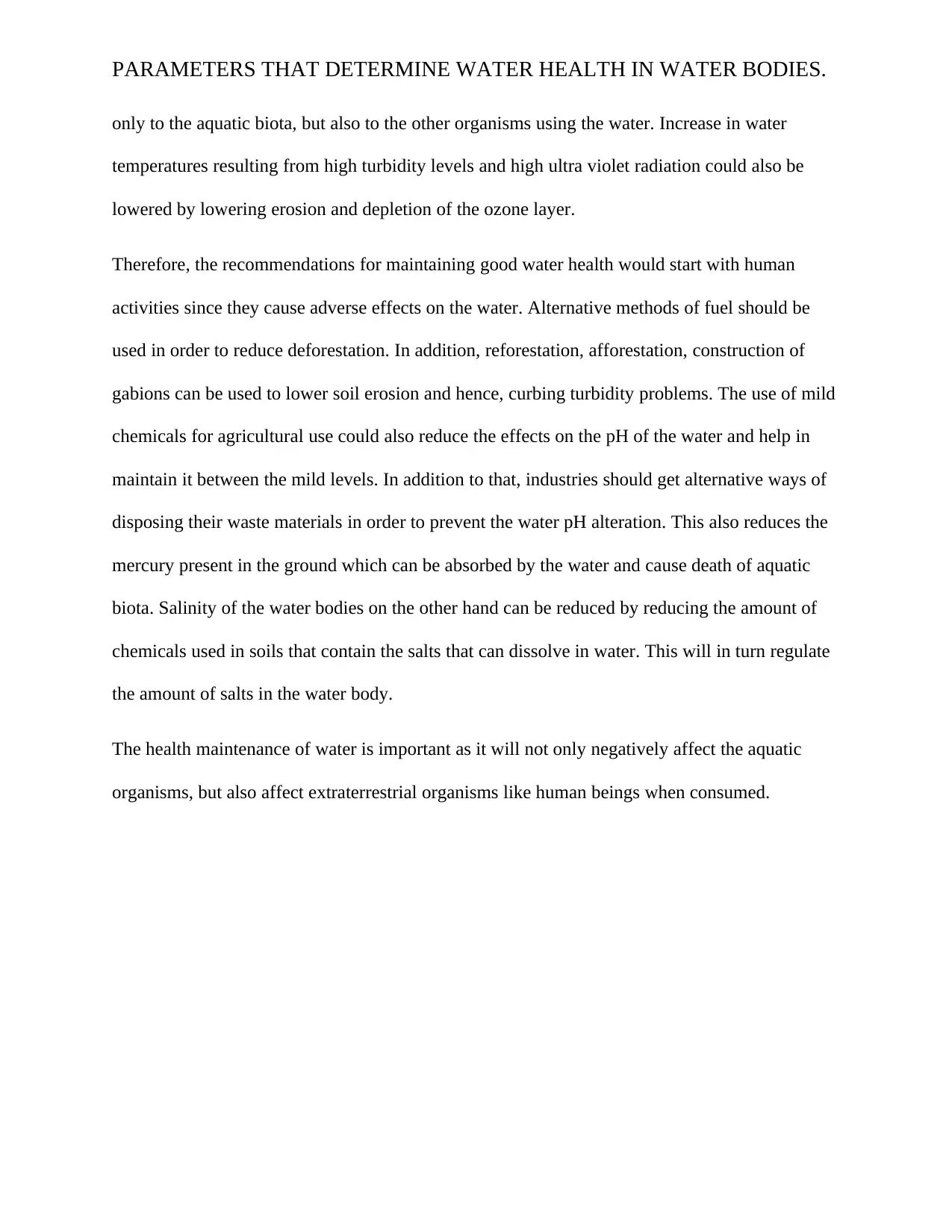
PARAMETERS THAT DETERMINE WATER HEALTH IN WATER BODIES.
only to the aquatic biota, but also to the other organisms using the water. Increase in water
temperatures resulting from high turbidity levels and high ultra violet radiation could also be
lowered by lowering erosion and depletion of the ozone layer.
Therefore, the recommendations for maintaining good water health would start with human
activities since they cause adverse effects on the water. Alternative methods of fuel should be
used in order to reduce deforestation. In addition, reforestation, afforestation, construction of
gabions can be used to lower soil erosion and hence, curbing turbidity problems. The use of mild
chemicals for agricultural use could also reduce the effects on the pH of the water and help in
maintain it between the mild levels. In addition to that, industries should get alternative ways of
disposing their waste materials in order to prevent the water pH alteration. This also reduces the
mercury present in the ground which can be absorbed by the water and cause death of aquatic
biota. Salinity of the water bodies on the other hand can be reduced by reducing the amount of
chemicals used in soils that contain the salts that can dissolve in water. This will in turn regulate
the amount of salts in the water body.
The health maintenance of water is important as it will not only negatively affect the aquatic
organisms, but also affect extraterrestrial organisms like human beings when consumed.
only to the aquatic biota, but also to the other organisms using the water. Increase in water
temperatures resulting from high turbidity levels and high ultra violet radiation could also be
lowered by lowering erosion and depletion of the ozone layer.
Therefore, the recommendations for maintaining good water health would start with human
activities since they cause adverse effects on the water. Alternative methods of fuel should be
used in order to reduce deforestation. In addition, reforestation, afforestation, construction of
gabions can be used to lower soil erosion and hence, curbing turbidity problems. The use of mild
chemicals for agricultural use could also reduce the effects on the pH of the water and help in
maintain it between the mild levels. In addition to that, industries should get alternative ways of
disposing their waste materials in order to prevent the water pH alteration. This also reduces the
mercury present in the ground which can be absorbed by the water and cause death of aquatic
biota. Salinity of the water bodies on the other hand can be reduced by reducing the amount of
chemicals used in soils that contain the salts that can dissolve in water. This will in turn regulate
the amount of salts in the water body.
The health maintenance of water is important as it will not only negatively affect the aquatic
organisms, but also affect extraterrestrial organisms like human beings when consumed.
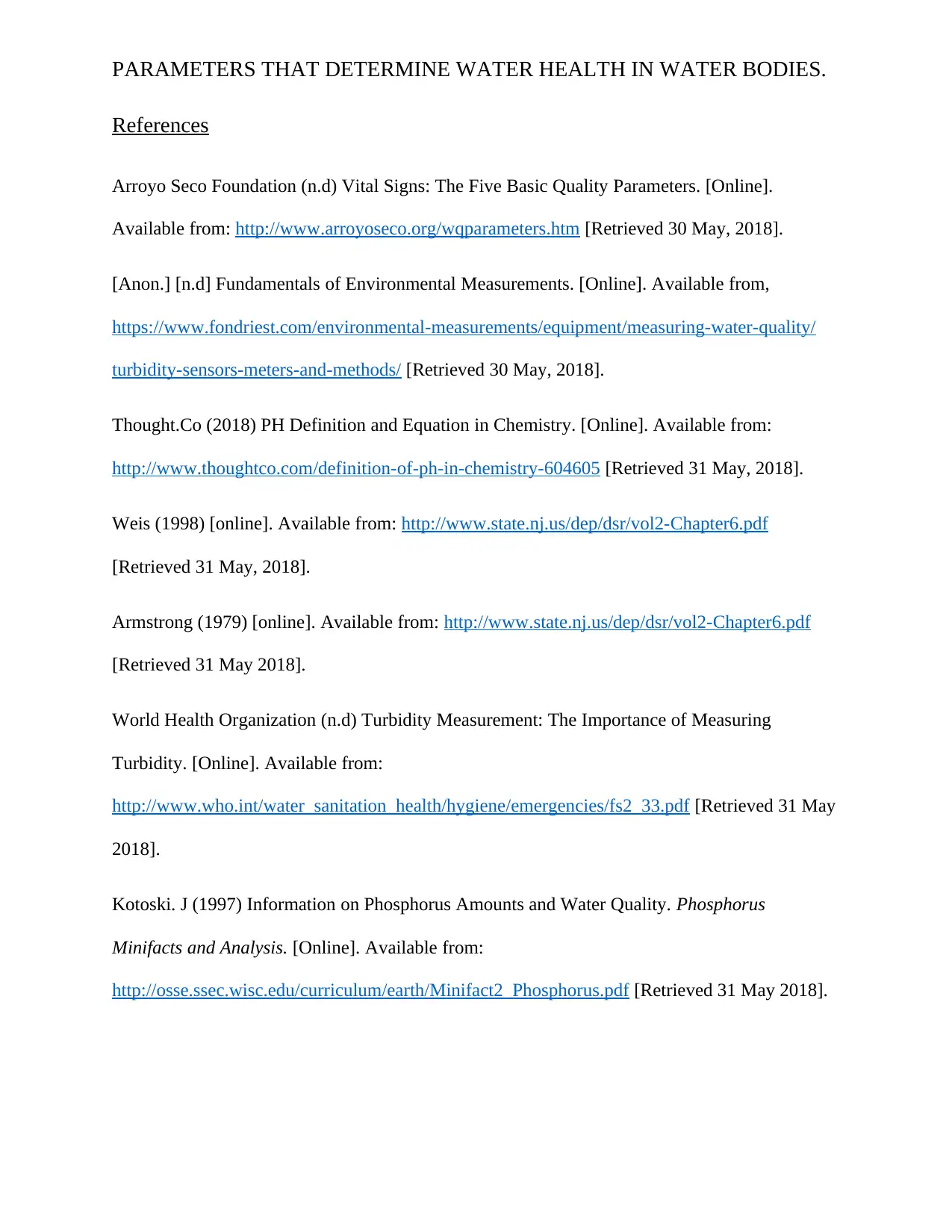
PARAMETERS THAT DETERMINE WATER HEALTH IN WATER BODIES.
References
Arroyo Seco Foundation (n.d) Vital Signs: The Five Basic Quality Parameters. [Online].
Available from: http://www.arroyoseco.org/wqparameters.htm [Retrieved 30 May, 2018].
[Anon.] [n.d] Fundamentals of Environmental Measurements. [Online]. Available from,
https://www.fondriest.com/environmental-measurements/equipment/measuring-water-quality/
turbidity-sensors-meters-and-methods/ [Retrieved 30 May, 2018].
Thought.Co (2018) PH Definition and Equation in Chemistry. [Online]. Available from:
http://www.thoughtco.com/definition-of-ph-in-chemistry-604605 [Retrieved 31 May, 2018].
Weis (1998) [online]. Available from: http://www.state.nj.us/dep/dsr/vol2-Chapter6.pdf
[Retrieved 31 May, 2018].
Armstrong (1979) [online]. Available from: http://www.state.nj.us/dep/dsr/vol2-Chapter6.pdf
[Retrieved 31 May 2018].
World Health Organization (n.d) Turbidity Measurement: The Importance of Measuring
Turbidity. [Online]. Available from:
http://www.who.int/water_sanitation_health/hygiene/emergencies/fs2_33.pdf [Retrieved 31 May
2018].
Kotoski. J (1997) Information on Phosphorus Amounts and Water Quality. Phosphorus
Minifacts and Analysis. [Online]. Available from:
http://osse.ssec.wisc.edu/curriculum/earth/Minifact2_Phosphorus.pdf [Retrieved 31 May 2018].
References
Arroyo Seco Foundation (n.d) Vital Signs: The Five Basic Quality Parameters. [Online].
Available from: http://www.arroyoseco.org/wqparameters.htm [Retrieved 30 May, 2018].
[Anon.] [n.d] Fundamentals of Environmental Measurements. [Online]. Available from,
https://www.fondriest.com/environmental-measurements/equipment/measuring-water-quality/
turbidity-sensors-meters-and-methods/ [Retrieved 30 May, 2018].
Thought.Co (2018) PH Definition and Equation in Chemistry. [Online]. Available from:
http://www.thoughtco.com/definition-of-ph-in-chemistry-604605 [Retrieved 31 May, 2018].
Weis (1998) [online]. Available from: http://www.state.nj.us/dep/dsr/vol2-Chapter6.pdf
[Retrieved 31 May, 2018].
Armstrong (1979) [online]. Available from: http://www.state.nj.us/dep/dsr/vol2-Chapter6.pdf
[Retrieved 31 May 2018].
World Health Organization (n.d) Turbidity Measurement: The Importance of Measuring
Turbidity. [Online]. Available from:
http://www.who.int/water_sanitation_health/hygiene/emergencies/fs2_33.pdf [Retrieved 31 May
2018].
Kotoski. J (1997) Information on Phosphorus Amounts and Water Quality. Phosphorus
Minifacts and Analysis. [Online]. Available from:
http://osse.ssec.wisc.edu/curriculum/earth/Minifact2_Phosphorus.pdf [Retrieved 31 May 2018].
⊘ This is a preview!⊘
Do you want full access?
Subscribe today to unlock all pages.

Trusted by 1+ million students worldwide

PARAMETERS THAT DETERMINE WATER HEALTH IN WATER BODIES.
1 out of 7
Your All-in-One AI-Powered Toolkit for Academic Success.
+13062052269
info@desklib.com
Available 24*7 on WhatsApp / Email
![[object Object]](/_next/static/media/star-bottom.7253800d.svg)
Unlock your academic potential
Copyright © 2020–2025 A2Z Services. All Rights Reserved. Developed and managed by ZUCOL.

